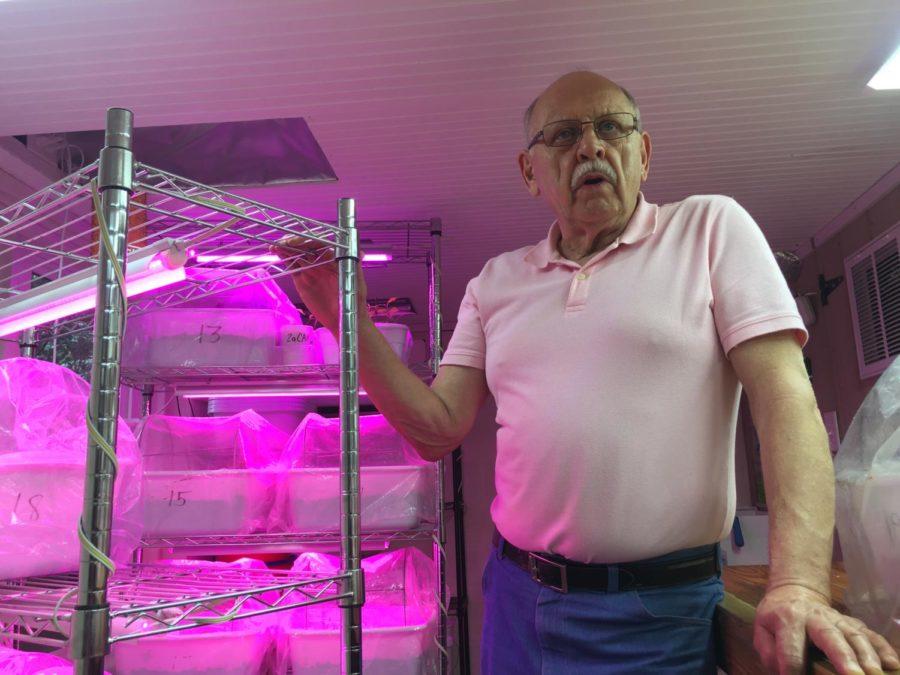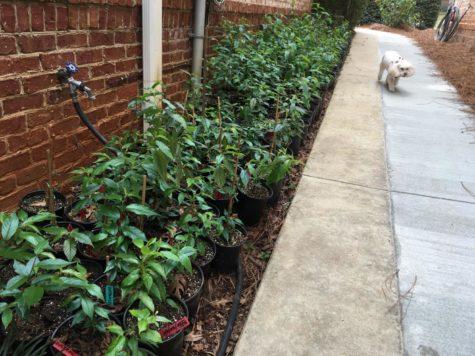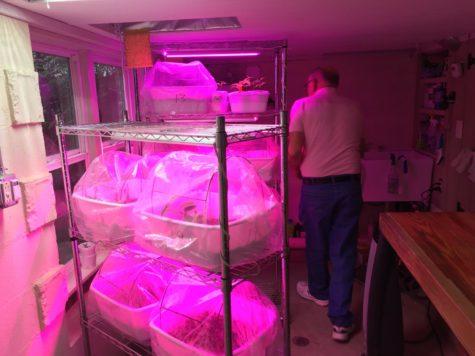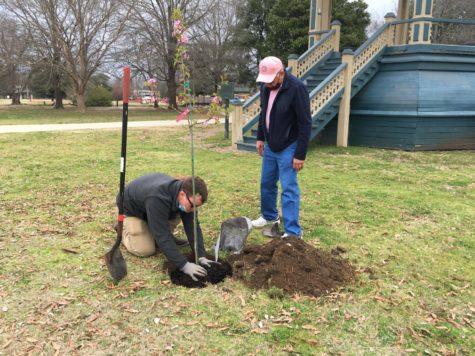
Caption
Master gardener Wayne Woodworth is trying to grow a better cherry blossom tree that will thrive in Macon.
Credit: Liz Fabian/CCJ

Master gardener Wayne Woodworth is trying to grow a better cherry blossom tree that will thrive in Macon.
The security of Macon’s status as “Cherry Blossom Capital of the World” could rest in Wayne Woodworth’s backyard.
On his tiny patch of the Providence neighborhood, Woodworth is trying to grow a better cherry tree.
The Yoshino, which is the star of the Macon-Bibb County’s annual signature festival, struggles in the hot Southern climate and has become susceptible to disease. Plus, the 20-year life expectancy is about up for many trees already in decline around town. Grafting can triple the lifespan in some climates, he’s learned.
“The roots don’t like to be wet for very long,” Woodworth told Keep Macon-Bibb Beautiful’s board last year. “So as for tree life, there’s a problem there.”
Shot hole fungus thrives in wet conditions and little can be done to stop it once trees have been infected. It only takes an unusually wet winter or spring for disease to set in.
If you see dark spots, or holes on the leaves, shot hole fungus is the likely culprit.
“Not a cherry tree that I know of is completely resistant,” Woodworth told the board last fall.

Prunus Campanulata, the Taiwan cherry seen here growing in pots at the Woodworth home, is more heat resistant than the Yoshino.
Along the walkway beside Woodworth’s home, hundreds of buckets of campanulata seedlings line the flower bed.
The Taiwan cherry tree, as it’s also known, thrives in northern Florida and is heat tolerant. It has proven to be good root stock for grafting Yoshinos to lengthen their lifespan. Prunus campanulata has a deep pink, almost red, bell-shaped blossom.
Woodworth, who grew up on a farm in western New York, has been on a quest to find the sturdiest cherry blossom tree to replace the dying Yoshinos.
So far, the best candidate is the “Helen Taft,” named for the former first lady of President William Taft. In 1912, she planted the first Yoshino in the Tidal Basin of Washington, D.C., with the wife of the Japanese ambassador.
The National Arboretum unveiled the new variety during the 2012 centennial celebration of that first tree planting.

A Helen Taft cherry tree recently planted in Carolyn Crayton Park displays pinker blossoms than the Yoshinos prominent in Macon.
The Helen Taft is a hybrid between the sterile yoshino and the Taiwan cherry and has a pinker blossom from the outset. Yoshino blossom petals are whiter but can turn to a deeper Pepto Bismol shade of pink by the time they drop to the ground.
Woodworth, a retired engineer who had a conveyor systems company in Chicago before moving South, is a master gardener.
Six years ago, a new friend he met at the Wellness Center asked him to escort her to the Cherry Blossom Ball. Jean McCarty Ivey, the 2015 Senior Princess, got him better acquainted with the festival and they married months later.
Woodworth was named to the Keep Macon-Bibb Beautiful Board in 2019 and added to the Arbor Conservation Board last year.

Wayne Woodworth walks past racks of Helen Taft scions rooting in tubs in the refurbished crawlspace of his north Macon home.
He’s spent countless hours researching the hundreds of varieties of cherry trees. His crawlspace is now a propagating lab full of plastic tubs under the pink glow of grow lights.
Scions with a few buds shoot up from Styrofoam coffee cups on multiple metal racks. He’s spent hundreds of dollars on growing medium alone.
He’s picked the brains of tree growers around the world and has read everything he can about cherry blossoms.
“I’d like to have an arboretum,” Woodword said during a recent tour of his operation. "If we’re the Cherry Blossom city, there should be more than Yoshinos because there are all different shades and shapes."
The festival touts planting more than 350,000 cherry trees over the years, and he wants to make sure there are at least that many still growing in the future, if not more.
Macon-Bibb also is part of the inaugural class of Tree Cities of the World, a designation it shares with Paris and New York City.
Cherry Blossom Festival Founder Carolyn Crayton said William A. Fickling Sr., the late businessman who in the '50s began sharing cuttings from his own Yoshino cherry trees, had expressed an interest in developing an arboretum.
She believes the community could support a Sakura Society to further explore the varieties and their history as living symbols of beauty and international friendship. Sakura is Japanese for cherry blossom.
Bill Fickling III, has picked up his grandfather’s penchant for the trees and maintains a log book of when they bloom.
In a Facebook post last month, Fickling explained the plight of his family’s trees both at his grandfather’s old house, where he now lives, and the Fickling Farm on Rivoli.
“In the last few years we’ve had very mild winters, and this has allowed shot hole fungus and tree-borer pests to affect the trees, and many of them in Macon are badly affected,” his post stated.
Recently, the family removed diseased trees and replanted along the fence on Rivoli, which is one of the highlights of the Cherry Blossom Trail.
“But it will be quite a few years before these locations are as beautiful as they once were,” he lamented.
The Ficklings have purchased dozens of the new Helen Taft trees that Woodworth found in a nursery in Pennsylvania. The Fickling Family Foundation helped with the cost of shipping.
A pair of Helen Tafts Woodworth brought back from his first fact-finding mission late last summer, already have spectacular pink blooms in his backyard. Those he had shipped early this year are a little bit behind in the process.

Macon-Bibb County Parks & Recreation director Michael Glisson plants a Helen Taft cherry tree at Carolyn Crayton Park in February.
Two of the new Helen Taft trees now flank the bandstand at Carolyn Crayton Park and others are planted at the entrance to Amerson River Park. You will also see its pinker blooms outside the Federated Garden Club on College Street.
Macon-Bibb Parks & Beautification director Michael Glisson explained why some are reluctant to replant Yoshinos.
“It’s not a tree you can just put in the ground and leave alone,” Glisson said.
But, there are simple ways to protect the trees from disease and pests.
“A lot of that can be mitigated with proper tree care,” Glisson said.
The executive director of the Keep Macon-Bibb Beautiful Board, Caroline Childs lives in Wesleyan Woods. Her neighborhood is home to the first planting of 500 Yoshinos Crayton organized with Fickling’s seedlings back in 1973.
“A lot of the cherry trees in our community are diseased,” Childs told her board a few months ago. “We can educate people on them.”

The Wesleyan Woods club has created a new flyer explaining how to properly care for cherry trees.
The Wesleyan Woods club has created a new flyer explaining how to properly care for cherry trees based on recommendations from Woodworth’s team of experts he consults.
“One of our goals this year is to continue to help the growth and revitalization of the cherry trees,” Childs said at the January meeting.
In addition to pruning dead and diseased branches and thinning excess canopy branches, growers should rake up and remove fallen leaves, test the soil and follow lime and fertilization recommendations.
Glisson wants to know if there are signs of peach tree borer around the base of the trunk. Email reports of the pests to Glisson6@gmail.com.
When you see buds in spring, spray Captan through the end of the flowering season. Every week or two, spray chloronthalonil, tebucanozole or myclobutanil until the trees leaves are expanded.
As Woodworth sold the Helen Tafts he ordered from Pennsylvania, he struck a deal to do the tree care if owners agreed to him taking cuttings so he can create more trees for the community.
“We’ll have the trees grow and contribute buds and branches so we can create more, similarly like Grandpa Fickling did 40 years ago,” Woodworth told the KMBB board in January.
KMBB also will be selling Yoshinos, 4 feet to 7 feet tall, for $15 at the Round Building at the park during the Cherry Blossom Festival March 19-28.
Woodworth’s efforts have drawn praise from KMBB board members and chairman Justin Hollingsworth: “It would be hard to imagine Macon without cherry trees, so thank you.”